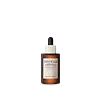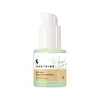What's inside
What's inside
 Key Ingredients
Key Ingredients

 Benefits
Benefits

 Concerns
Concerns

No concerns
 Ingredients Side-by-side
Ingredients Side-by-side

Centella Asiatica Extract
CleansingButylene Glycol
HumectantGlycerin
HumectantWater
Skin ConditioningPropanediol
SolventCaprylic/Capric Triglyceride
MaskingNiacinamide
SmoothingLactobacillus/Centella Asiatica Extract Ferment Filtrate
Skin Conditioning1,2-Hexanediol
Skin ConditioningDipropylene Glycol
HumectantPolyglyceryl-3 Distearate
EmulsifyingAcrylates/C10-30 Alkyl Acrylate Crosspolymer
Emulsion StabilisingC14-22 Alcohols
Emulsion StabilisingArginine
MaskingHydrogenated Lecithin
EmulsifyingBetaine
HumectantAllantoin
Skin ConditioningPanthenol
Skin ConditioningHydroxystearic Acid
CleansingEthylhexylglycerin
Skin ConditioningHydroxyethyl Acrylate/Sodium Acryloyldimethyl Taurate Copolymer
Emulsion StabilisingGlyceryl Stearate Citrate
EmollientSodium Polyacrylate
AbsorbentAdenosine
Skin ConditioningC12-20 Alkyl Glucoside
EmulsifyingCetearyl Alcohol
EmollientXanthan Gum
EmulsifyingMacadamia Ternifolia Seed Oil
EmollientSodium Phytate
Sodium Hyaluronate
HumectantStearic Acid
CleansingCeramide NP
Skin ConditioningGlyceryl Acrylate/Acrylic Acid Copolymer
HumectantSorbitan Isostearate
EmulsifyingPolyglyceryl-10 Myristate
Skin ConditioningMadecassic Acid
Skin ConditioningAsiaticoside
AntioxidantPhytosphingosine
Skin ConditioningAsiatic Acid
Skin ConditioningSucrose Distearate
EmollientPolyglutamic Acid
Skin ConditioningGlucose
HumectantLauric Acid
CleansingPhytosterols
Skin ConditioningCentella Asiatica Extract, Butylene Glycol, Glycerin, Water, Propanediol, Caprylic/Capric Triglyceride, Niacinamide, Lactobacillus/Centella Asiatica Extract Ferment Filtrate, 1,2-Hexanediol, Dipropylene Glycol, Polyglyceryl-3 Distearate, Acrylates/C10-30 Alkyl Acrylate Crosspolymer, C14-22 Alcohols, Arginine, Hydrogenated Lecithin, Betaine, Allantoin, Panthenol, Hydroxystearic Acid, Ethylhexylglycerin, Hydroxyethyl Acrylate/Sodium Acryloyldimethyl Taurate Copolymer, Glyceryl Stearate Citrate, Sodium Polyacrylate, Adenosine, C12-20 Alkyl Glucoside, Cetearyl Alcohol, Xanthan Gum, Macadamia Ternifolia Seed Oil, Sodium Phytate, Sodium Hyaluronate, Stearic Acid, Ceramide NP, Glyceryl Acrylate/Acrylic Acid Copolymer, Sorbitan Isostearate, Polyglyceryl-10 Myristate, Madecassic Acid, Asiaticoside, Phytosphingosine, Asiatic Acid, Sucrose Distearate, Polyglutamic Acid, Glucose, Lauric Acid, Phytosterols
Water
Skin ConditioningButylene Glycol
HumectantPentylene Glycol
Skin ConditioningPolyglyceryl-4 Caprate
EmulsifyingMaris Aqua
HumectantAmmonium Polyacryloyldimethyl Taurate
Emulsion StabilisingPanthenol
Skin ConditioningPropanediol
SolventMadecassoside
AntioxidantAcetyl Glutamine
Skin ConditioningLecithin
EmollientDisodium EDTA
Ethylhexylglycerin
Skin ConditioningBacillus
Skin ConditioningCaprylyl Glycol
EmollientSh-Oligopeptide-1
Skin ConditioningSh-Oligopeptide-2
Skin ConditioningSh-Polypeptide-1
Skin ConditioningSh-Polypeptide-11
Sh-Polypeptide-9
Skin ConditioningSodium Hyaluronate
HumectantXanthan Gum
EmulsifyingEmiliania Huxleyi Extract
Skin Conditioning1,2-Hexanediol
Skin ConditioningWater, Butylene Glycol, Pentylene Glycol, Polyglyceryl-4 Caprate, Maris Aqua, Ammonium Polyacryloyldimethyl Taurate, Panthenol, Propanediol, Madecassoside, Acetyl Glutamine, Lecithin, Disodium EDTA, Ethylhexylglycerin, Bacillus, Caprylyl Glycol, Sh-Oligopeptide-1, Sh-Oligopeptide-2, Sh-Polypeptide-1, Sh-Polypeptide-11, Sh-Polypeptide-9, Sodium Hyaluronate, Xanthan Gum, Emiliania Huxleyi Extract, 1,2-Hexanediol
 Reviews
Reviews

Ingredients Explained
These ingredients are found in both products.
Ingredients higher up in an ingredient list are typically present in a larger amount.
1,2-Hexanediol is a synthetic liquid and another multi-functional powerhouse.
It is a:
- Humectant, drawing moisture into the skin
- Emollient, helping to soften skin
- Solvent, dispersing and stabilizing formulas
- Preservative booster, enhancing the antimicrobial activity of other preservatives
Butylene Glycol (or BG) is used within cosmetic products for a few different reasons:
Overall, Butylene Glycol is a safe and well-rounded ingredient that works well with other ingredients.
Though this ingredient works well with most skin types, some people with sensitive skin may experience a reaction such as allergic rashes, closed comedones, or itchiness.
Learn more about Butylene GlycolEthylhexylglycerin (we can't pronounce this either) is commonly used as a preservative and skin softener. It is derived from glyceryl.
You might see Ethylhexylglycerin often paired with other preservatives such as phenoxyethanol. Ethylhexylglycerin has been found to increase the effectiveness of these other preservatives.
Panthenol is a common ingredient that helps hydrate and soothe the skin. It is found naturally in our skin and hair.
There are two forms of panthenol: D and L.
D-panthenol is also known as dexpanthenol. Most cosmetics use dexpanthenol or a mixture of D and L-panthenol.
Panthenol is famous due to its ability to go deeper into the skin's layers. Using this ingredient has numerous pros (and no cons):
Like hyaluronic acid, panthenol is a humectant. Humectants are able to bind and hold large amounts of water to keep skin hydrated.
This ingredient works well for wound healing. It works by increasing tissue in the wound and helps close open wounds.
Once oxidized, panthenol converts to pantothenic acid. Panthothenic acid is found in all living cells.
This ingredient is also referred to as pro-vitamin B5.
Learn more about PanthenolPropanediol is an all-star ingredient. It softens, hydrates, and smooths the skin.
It’s often used to:
Propanediol is not likely to cause sensitivity and considered safe to use. It is derived from corn or petroleum with a clear color and no scent.
Learn more about PropanediolSodium Hyaluronate is hyaluronic acid's salt form. It is commonly derived from the sodium salt of hyaluronic acid.
Like hyaluronic acid, it is great at holding water and acts as a humectant. This makes it a great skin hydrating ingredient.
Sodium Hyaluronate is naturally occurring in our bodies and is mostly found in eye fluid and joints.
These are some other common types of Hyaluronic Acid:
Learn more about Sodium HyaluronateWater. It's the most common cosmetic ingredient of all. You'll usually see it at the top of ingredient lists, meaning that it makes up the largest part of the product.
So why is it so popular? Water most often acts as a solvent - this means that it helps dissolve other ingredients into the formulation.
You'll also recognize water as that liquid we all need to stay alive. If you see this, drink a glass of water. Stay hydrated!
Learn more about WaterXanthan gum is used as a stabilizer and thickener within cosmetic products. It helps give products a sticky, thick feeling - preventing them from being too runny.
On the technical side of things, xanthan gum is a polysaccharide - a combination consisting of multiple sugar molecules bonded together.
Xanthan gum is a pretty common and great ingredient. It is a natural, non-toxic, non-irritating ingredient that is also commonly used in food products.
Learn more about Xanthan Gum